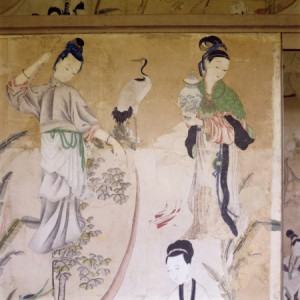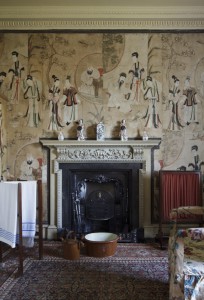

Britain (ar.1760s)
Pictures depicting large emblematic male and female figures in garden settings used as wallpaper in the Chinese Dressing Room in Saltram Palace
Ink on mulberry paper
National Trust Inventory No. 872998
Exhibition: Chinoiserie Gallery 2015
Chinoiserie reflects fanciful European interpretations of Chinese styles that used for furniture, pottery, textiles, interiors and garden design. Since early 17th century, craftsman draw sources from decorative forms found on imported goods from China such as cabinets, porcelain vessels, and embroideries.
At the beginning of the 18th century, Chinese craftsman and workshops start to create hand-painted wallpapers that were specifically made for exportation to the European market, and by the early 19th century no European palace was complete without a Chinoiserie room. Some extraordinary examples can still be seen in the Brighton Pavilon, Saltram, Sans Souci, Chateau Chantilly and Nostell Priory. The example we using here is from the Chinese room of Saltram Palace, which is a dressing room.
Chinoiserie wallpaper was commonly used in bedroom, dressing room and drawing room. It seems to have been rare, at least in Britain, for Chinese wallpaper to be used in the ‘masculine’ or formal areas of a house. Distinct from the state apartments and great rooms associated with the male head of the household, ‘feminine’ areas such as bedrooms, dressing rooms and drawing rooms seem to have been poised between the private and the public sphere. From the early eighteenth century onwards there appears to have been a tendency to link orientalism, femininity and sociability, as women use their chinoiserie styled dressing room to host their social activities. Therefore, apart from being a personal taste, chinoiserie interior shows strong famine characteristics. As Elizabeth Montagu pointed out ‘I assure you the dressing room is now just the female of the great room, for sweet attractive grace, for winning softness, for le je ne sais quoi it is incomparable’
This wallpaper in the Chinese Dressing Room, painted on mulberry paper, is probably the oldest at Saltram, dating from the early eighteenth century, and depicts elegant people in a garden setting. Multiple copies of two Chinese hand-colored prints that have been hung in alternating pairs cover the Main wall of the room. The pictures are first printed on paper and then being colored by hand. The printing often extends beyond the outlines to include various other details. Repeated elements on some painted wallpapers suggests that they were produced by the meticulously tracing motifs from a common reference.
The most common procedure of hanging wallpaper was to stretch canvas or another open-weave fabric across the bare wall and nail it down onto wooden battens, then to size it and to cover it with a lining of individual sheets of European hand-made paper, and finally to attach the Chinese paper on top. If the drops did not quite cover the walls, the paper hangers would add border papers, unobtrusively insert sections of wallpaper taken from elsewhere or add new, extended skies. The greater width of Chinese wallpapers and the different reaction of Chinese paper to wallpaper paste presented additional challenges. In their advertisements paper hangers would therefore explicitly and proudly mention their ability to hang Chinese wallpaper.
In Figure 1,2,3, the skillful way in which the joins between the prints have been disguised, by cutting off the top margins around certain motifs and by the addition of certain cut-out motifs, suggests the involvement of a professional paper hanger.
Looking at the wallpaper, we realized that the painting is excitingly exotic, and yet it included elements that have been comfortingly familiar to the western eye. Chinese artists applied techniques and devices originally derived from western painting. During the late Ming and early Qing periods (roughly equivalent to the seventeenth century) some western illusionistic techniques like linear perspective, chiaroscuro and the depiction of interconnected spaces were introduced to China by Jesuit painters working at the imperial court and through the circulation of western prints. These techniques also appear in Chinese wallpaper or pictures used as wallpaper, especially in the depiction of volumetric shading in costumes and perspective and spatial recession in architecture.
Apart from the enduring popularity of these wallpapers, their physical survival is an equally astonishing phenomenon. Inevitably the papers have aged, not least as a result of use and imperfect environments. Typical deterioration and conservation challenges include delamination and staining of the paper, fading and localised flaking of certain pigments, inappropriate repairs and loss caused by the grazing of silverfish. However, the conservation of Chinese wallpapers in the west has developed considerably over the last few decades. By the early 1960s the wallpaper had become detached from the wall in places, and conservation treatment (including relining) was carried out by C.P. Sharpe of London in 1962.The scheme was removed from the walls, treated and relined by Merryl Huxtable and Pauline Webber in 1987, in conjunction with G. Jackson and Sons.
Bibliography:
- ISBN 978-0-7078-0428-6 © 2014 National Trust. Registered charity no. 205846 Text by Emile de Bruijn, Andrew Bush, Dr Helen Clifford Edited by Claire Forbes Designed by LEVEL • levelpartnership.co.uk
- To cite this article: Vanessa Alayrac‐Fielding (2009) ‘Frailty, thy name is China’: women, chinoiserie and the threat of low culture in eighteenth‐century England, Women’s History Review, 18:4, 659-668, DOI: 10.1080/09612020903112398 To link to this article: http://dx.doi.org/10.1080/09612020903112398